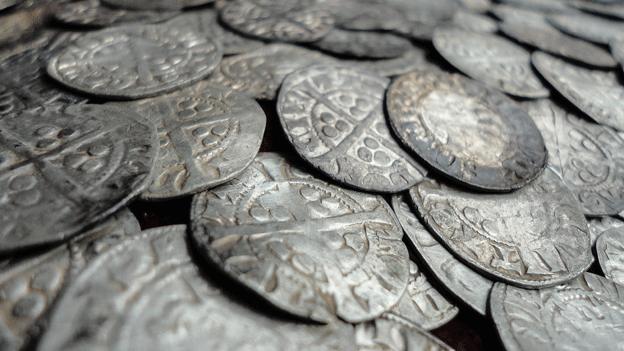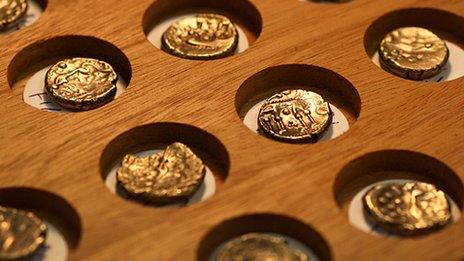Rare silver coins found in Derbyshire declared treasure
- Published

The oldest coin in the hoard dates from 1154 and features the image of King Stephen
Silver 12th Century coins found in a field in Derbyshire have been declared treasure by a coroner.
The 10 coins were unearthed by several metal detectorists in 2014 and date from the reigns of King Stephen and King Henry II.
Historians believe they were probably originally in a purse dropped by a trader and amounted to about a week's wages.
The coroner's decision paves the way for a museum to acquire them.
The exact location of the hoard cannot be revealed but was in a field near Clowne, which historians say was sparsely populated in the medieval period.

The silver penny was the only coin minted at the time so they were cut in half to pay smaller sums
The oldest of the coins dates from 1154 - the last year of King Stephen's reign - while the the rest date from the early years of King Henry II's reign.
They were struck at different mints around the country, with several made in Lincoln and the others from Oxford, London, York, Winchester, Bury St Edmunds and Thetford.
Gareth Williams, curator of early medieval coins at the British Museum, said: "It's a not inconsiderable amount of money - perhaps a week's wages - it would have meant quite a lot to whoever lost it," he said.
"This find gives a bit of a picture of what's going on commercially. The presence of several different mints is not a surprise, any market trader in Worksop would probably have a similar selection of mints from around England."

It is difficult to tell if the coins were poorly made or if age has worn them down
He estimates the purse was lost in the late 1150s or the 1160s during a period of relative stability, further evidence the coins may have been lost accidentally rather than buried to save for a later date.
The find is not considered of national importance - the British Museum does not want to acquire the coins - but it is rare for the East Midlands.
"We don't get an awful lot of hoards from this period - maybe two or three in the last 20 years," Mr Williams said.

During the early years of King Henry II, the emphasis was on the quantity of coins made, not the quality. The quality of the design and techniques used were later improved.
Dr Williams said this was partly because there were not many people living there in the 12th Century, but also because areas such as Norfolk, Essex and Lincolnshire had a reputation for hoards of treasure, attracting metal dectorists.
The hoard now becomes the property of the crown and a valuation committee will determine what the coins are worth.
If a museum wants the collection, it has the chance to reserve them and is given time to raise the money.

Treasure is...
Any object that is at least 300 years old when found and:
is one of at least two coins in the same find with a precious metal content of at least 10%
is one of at least 10 coins in the same find, if the precious metal content is less than 10%
is not a coin but has precious metal content of at least 10%
is a group of two or more metallic objects of any composition of prehistoric date that come from the same find
is an object substantially made from gold or silver but is less than 300 years old

- Published11 August 2016

- Published17 January 2016

- Published19 June 2015

- Published4 February 2014

- Published17 April 2014
